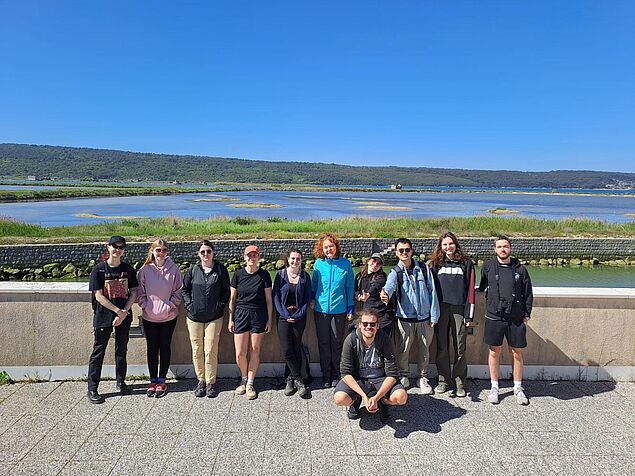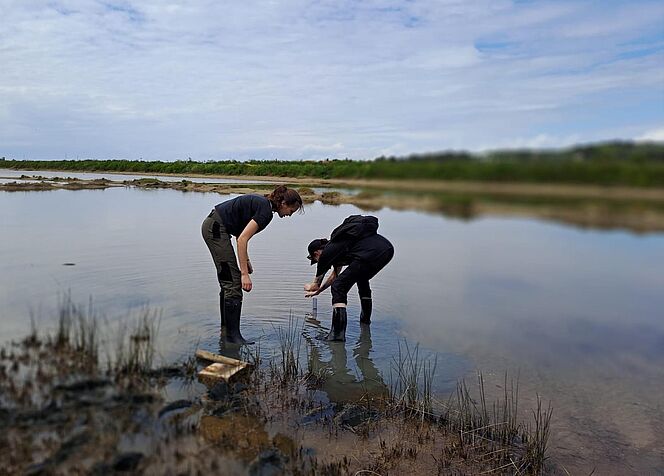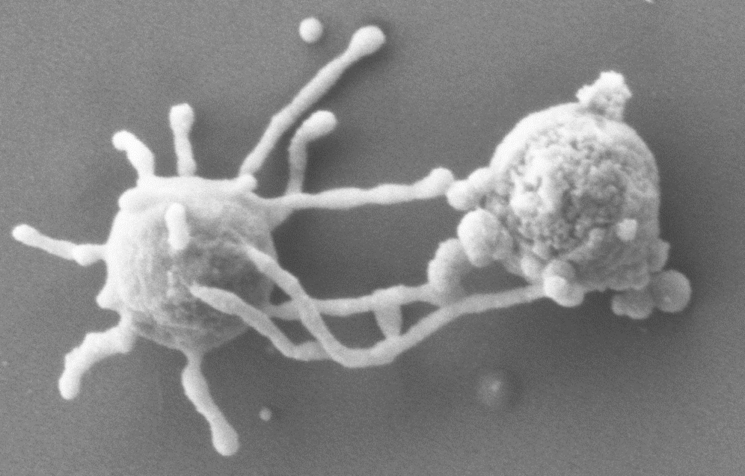Ecology and Evolution of Archaea, Environmental Genomics
Wittgenstein Prize
Archaea emerged as a lineage independently from Bacteria about 4 billion years ago on Earth. Although they are mostly known and studied from extreme environments, archaea also play important roles in biogeochemical cycles of moderate ecosystems, such as oceans, lakes, sediments and soils. In addition, their role in the early evolution of the first complex life forms is undebated and receives a lot of attention due to recent findings of novel archaeal lineages. In this project, two groups of archaea that play important ecological and/or evolutionary roles will be studied, ammonia oxidizing archaea and Asgardarchaea.
Ammonia oxidizing archaea were discovered in aquatic and terrestrial environments and are together with certain lineages of bacteria responsible for the conversion of nitrogen compounds by oxidizing ammonia to nitrite. Their activity directly and indirectly influences the availability of nutrients to plants and can fuel the production of the strong greenhouse gas nitrous oxide from soil.
Nitrososphaera viennensis, an ammonia oxidizing archaeon from soil isolated in Vienna will serve as the model organism to study the physiology and biochemistry of ammonia oxidizing archaea. In particular its metabolic capabilities beyond aerobic ammonia oxidation will be explored as well as particular proteins that we assume have emerged in ammonia oxidizers to enable them to radiate into many moderate aerobic environments on earth. The second archaeal group are Asgardarchaea, that were only discovered in 2015 as the closest known microbial sister lineage of complex organisms, i.e. of all plants, animals and fungi (collectively termed eukaryotes). Asgardarchaea contain hundreds of proteins so far only known in eukaryotes and thus give clues about the evolution of the last eukaryotic common ancestor. Candidatus Lokiarchaeum ossiferum, recently cultivated from anoxic marine sediments by our group will serve as a new model organism. The characterization of its cellular components in particular its dynamic cytoskeleton and the ability for vesicle transport and membrane remodeling will reveal the extent to which features are shared with eukaryotes.
This will shed light on the evolutionary emergence of complex life forms from simpler microorganisms. The project will also involve ecological aspects by studying the environmental distribution of both, ammonia oxidizing archaea and Asgardarchaea in terrestrial environments and sediments and by attempting to bring further model organisms into laboratory cultures.
Duration: 01.03.2023-28.02.2028
Funding agency: Austrian Science Fund (FWF): Z 437 Wittgenstein-Preis
Awardee: Prof. Christa Schleper
Related papers
Asgard archaea discovery, ecology, evolution, isolation and functional studies
- Rodrigues-Oliveira T, Wollweber F, Ponce-Toledo RI, Xu J, Rittmann SKR, Klingl A, Pilhofer M, Schleper C. (2023). Actin cytoskeleton and complex cell architecture in an Asgard archaeon. Nature 613(7943):332-339. doi: 10.1038/s41586-022-05550-y
- Grau-Bové X, Navarrete C, Chiva C, Pribasnig T, Antó M, Torruella G, Galindo LJ, Lang BF, Moreira D, López-Garcia P, Ruiz-Trillo I, Schleper C, Sabidó E, Sebé-Pedrós A. (2022) A phylogenetic and proteomic reconstruction of eukaryotic chromatin evolution. Nature Ecology and Evolution 6(7):1007- 1023. doi: 10.1038/s41559-022-01771-6.
- Schleper C, Sousa F (2020) News and views: Meet the relatives of our cellular ancestors. Nature 577:478-479. DOI: 10.1038/d41586-020-00039-y. News and views
- Manoharan L, Kozlowski JA, Murdoch RW, Löffler FE, Sousa FL, Schleper C (2019) Metagenomes from Coastal Marine Sediments Give Insights into the Ecological Role and Cellular Features of Loki- and Thorarchaeota. mBio 10 (5): e02039--‐19. DOI: 10.1128/mBio.02039--‐19.
- Spang A, Saw JH, Jørgensen SL, Zaremba-Niedzwiedzka K, Martijn J, Lind AE, van Eijk R, Schleper C, Guy L, Ettema TJ (2015) Complex archaea that bridge the gap between prokaryotes and eukaryotes. Nature 521(7551): 173-179. DOI: 10.1038/nature14447.
- Jørgensen S, Thorseth I, Pedersen R, Baumberger T, Schleper C (2013) Quantitative and phylogenetic study of the Deep Sea Archaeal Group in sediments of the Arctic mid-ocean spreading ridge. Frontier in Microbiology 4: 299. DOI: 10.3389/fmicb.2013.00299
- Jørgensen S, Hannisdal B, Lanzen A, Baumberger T, Flesland K, Fonseca R, Ovreas L, Steen IH, Torseth IH, Pedersen RB, Schleper C (2012) Correlating microbial community profiles with geochemical data in highly stratified sediments from the Arctic Mid-Ocean Ridge. Proceedings of the National Academy of Sciences of the United States of America 109(42): E2846-E2855. DOI: 10.1073/pnas.1207574109.
Ecology and evolution of ammonia-oxidizing archaea
- Kerou M, Ponce-Toledo R, Zhao R, Abby SS, Hirai M, Nomaki H, Takaki Y, Nunoura T, Jørgensen S, Schleper C. (2021) Genomes of Thaumarchaeota from deep sea sediments reveal specific adaptations of three independently evolved lineages. The ISME Journal 15: 2792-2808. DOI: 10.1038/s41396-021-00962-6.
- Wang H, Bagnoud A, Ponce-Toledo RI, Kerou M, Weil M, Schleper C, Urich T. (2021) Linking 16SrRNA Gene Classification to amoA Gene Taxonomy Reveals Environmental Distribution of Ammonia-Oxidizing Archaeal Clades in Peatland Soils. mSystems: e0054621. DOI: 10.1128/mSystems.00546-21
- Abby SS, Kerou M, Schleper C (2020) Ancestral Reconstructions Decipher Major Adaptations of Ammonia-Oxidizing Archaea upon Radiation into Moderate Terrestrial and Marine Environments. mBio 11(5): e02371-21. DOI: 10.1128/mBio.02371-20.
- Zhao R, Mogollon JM, Abby S, Schleper C, Biddle JF, Roerdink DL, Thorseth IH, Joergensen SL (2020) Geochemical transition zone powering microbial growth in subsurface sediments. Proceedings of the National Academy of Sciences of the United States of America 117(51): 32617- 32626. DOI: 10.1073/pnas.2005917117.
- Siljanen HMP, Alves RJE, Ronkainen JG, Lamprecht RE, Bhattarai HR, Bagnoud A, Marushchak ME, Martikainen PJ, Schleper C, Biasi C (2019) Archaeal nitrification is a key driver of high nitrous oxide emissions from arctic peatlands. Soil Biology and Biochemistry 137: 107539. DOI: 10.1016/j.soilbio.2019.107539
- Alves RJE, Minh BQ, Urich T, von Haeseler A, Schleper C (2018) Unifying the global phylogeny and environmental distribution of ammonia-oxidising archaea based on amoA genes. Nature communications 9(1): 1517. DOI: 10.1038/s41467-018-03861-1
- Elling FJ, Könneke M, Nicol GW, Stieglmeier M, Bayer B, Spieck E, de la Torre JR, Becker KW, Thomm M, Prosser JI, Herndl GJ, Schleper C, Hinrichs KU (2017) Chemotaxonomic characterisation of the thaumarchaeal lipidome. Environmental Microbiology 19(7): 2681-2700. DOI: 10.1111/1462-2920.13759.
- Kerou M, Alves RJE, Schleper C (2016) Class Nitrososphaeria. In: Bergey’s Manual of Systematics of Archaea and Bacteria. William B. Whitman (ed.). Wiley Online Library. DOI: 10.1002/9781118960608.cbm00055
- Kerou M, Schleper C (2016) Family Nitrososphaeraceae. In: Bergey’s Manual of Systematics of Archaea and Bacteria. William B. Whitman (ed.). Wiley Online Library. DOI: 10.1002/9781118960608.fbm00265
- Kerou M, Schleper C (2016) Genus Nitrososphaera. In: Bergey’s Manual of Systematics of Archaea and Bacteria. William B. Whitman (ed.). Wiley Online Library. DOI: 10.1002/9781118960608.gbm01294
- Alves RJ, Wanek W, Zappe A, Richter A, Svenning MM, Schleper C, Urich T (2013) Nitrification rates in Arctic soils are associated with functionally distinct populations of ammonia-oxidizing archaea. ISME Journal 7(8): 1620-1631. DOI: 10.1038/ismej.2013.35.
- Offre P, Spang A, Schleper C (2013) Archaea in Biogeochemical Cycles. Annual Review of Microbiology 67: 437-457. DOI: 10.1146/annurev-micro-092412-155614
- Pester M, Schleper C, Wagner M (2011) The Thaumarchaeota: an emerging view of their phylogeny and ecophysiology. Current Opinion in Microbiology 14(3): 300-306. DOI: 10.1016/j.mib.2011.04.007
- Spang A, Hatzenpichler R, Brochier-Armanet C, Rattei T, Tischler P, Spieck E, Streit W, Stahl DA, Wagner M, Schleper C (2010) Distinct gene set in two different lineages of ammonia-oxidizing archaea supports the phylum Thaumarchaeota. Trends in Microbiology 18(8): 331-340. DOI: 10.1016/j.tim.2010.06.003
- Reeve JN, Schleper C (2011) Archaea: very diverse, often different but never bad? Current Opinion in Microbiology 14(3): 271-273. DOI: 10.1016/j.mib.2011.04.011
- Nicol, G. W., Leininger, S., Schleper, C., & Prosser, J. I. (2008). The influence of soil pH on the diversity, abundance and transcriptional activity of ammonia oxidizing archaea and bacteria. Environmental microbiology, 10(11), 2966–2978. https://doi.org/10.1111/j.1462-2920.2008.01701.x
- Leininger, S., Urich, T., Schloter, M., Schwark, L., Qi, J., Nicol, G. W., Prosser, J. I., Schuster, S. C., & Schleper, C. (2006). Archaea predominate among ammonia-oxidizing prokaryotes in soils. Nature, 442(7104), 806–809. doi.org/10.1038/nature04983
- Treusch, A. H., Leininger, S., Kletzin, A., Schuster, S. C., Klenk, H. P., & Schleper, C. (2005). Novel genes for nitrite reductase and Amo-related proteins indicate a role of uncultivated mesophilic crenarchaeota in nitrogen cycling. Environmental microbiology, 7(12), 1985–1995. doi.org/10.1111/j.1462-2920.2005.00906.x







